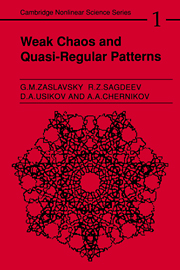Book contents
9 - Chaos of stream lines
Published online by Cambridge University Press: 29 October 2009
Summary
In the previous chapter we showed that in two-dimensional hydrodynamics there can exist flows with patterns displaying symmetry and quasi-symmetry. However, the picture drawn in the previous chapter is poor compared to the one we are now going to present. Three-dimensional dynamics introduces us to a qualitatively new phenomenon – the existence of stream lines chaotically arranged in space – which is sometimes called the Lagrangian turbulence. Various forms of this phenomenon have interesting practical applications and have played an important role in our understanding of the onset of turbulence, as well. In this chapter we are going to establish the relation between the structural properties of steady-state three-dimensional flows and the chaos of stream lines in these flows. This relation will sufficiently improve our understanding of those domains of physics where a stochastic web is mentioned. At the same time, we shall notice universality in the manifestations of quasi-symmetry in physical objects as different as the phase portrait of a dynamic system in phase space and the geometrical pattern of a steady-state flow of a liquid in coordinate space.
Stream lines in space
Stream lines of two-dimensional flows have a very simple structure and coincide with lines of the level of the stream function ψ(x, y). The behaviour of stream lines in steady-state three-dimensional flows can be completely different, since three-dimensional dynamics differs drastically from two-dimensional dynamics.
Information
- Type
- Chapter
- Information
- Weak Chaos and Quasi-Regular Patterns , pp. 188 - 210Publisher: Cambridge University PressPrint publication year: 1991
Accessibility standard: Unknown
Why this information is here
This section outlines the accessibility features of this content - including support for screen readers, full keyboard navigation and high-contrast display options. This may not be relevant for you.Accessibility Information
- 1
- Cited by
